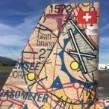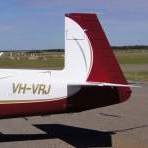
1980Mooney
Basic Member-
Posts
2,745 -
Joined
-
Last visited
-
Days Won
4
1980Mooney last won the day on August 24 2023
1980Mooney had the most liked content!
Recent Profile Visitors
8,247 profile views
1980Mooney's Achievements
-
"Un-Happy Endings" For Flight to Oshkosh
1980Mooney replied to 1980Mooney's topic in Mooney Safety & Accident Discussion
It occurred Wednesday, July 24 at 12:45 PM. Also earlier on Wednesday, at 8:21 AM, a Cirrus SR22T wingtip struck the front of a Lancair LC-40-550 (actually built as an early Cessna model) while taxiing in the same general area at KATW. Using map and GPS satellite scale, some of those taxiways might only be 38-40 ft wide. From your picture I can see how a Cirrus with 38 ft wingspan might drift off centerline to one side if the pilot is not vigilant or is trying to avoid something on the other side. It is harder to understand how a 35 ft wingspan Mooney could hit planes on both sides with both wings unless it over reacted/ over corrected after striking the first rather than stopping. Sounds like speed might be a factor. Still the parking density is inviting trouble. -
It appears that a trip from Albuquerque Double Eagle to attend Oshkosh ended badly for Mooney M20J, N555ED. It landed at Appleton (KATW), 16 nm to the North of KOSH, , on the morning of Sunday, July 21, the day before AirVenture started. It appears to have immediately taxied to a grass tiedown area. Yesterday afternoon it taxied from the grass tie down area but stopped near some hangars. FAA reports that the Mooney "struck other aircraft" (2?..more?) with both its left and right wings while taxiing. Crowding due to the insanity of AirVenture? Poor taxiway conditions? Stuck throttle? All of the above?! The long return trip will be somber - either commercial or ferry permit. https://globe.adsbexchange.com/?icao=a71266&lat=44.254&lon=-88.515&zoom=15.5&showTrace=2024-07-21&trackLabels×tamp=1721578027 https://globe.adsbexchange.com/?icao=a71266&lat=44.250&lon=-88.514&zoom=16.8&showTrace=2024-07-24&trackLabels×tamp=1721843098
-
Umm....just exactly "who missed it"? The person who submitted the equipment list to post on Controller or the Buyer who did not do a prebuy? Were hi-res pictures of the panel posted in the advertisement or shared with the Buyer? If so "whose eyes" missed the "impossible to miss" designation. Same thing - did the Buyer sit in the cockpit before closing the transaction? If so "whose eyes" missed the "impossible to miss"? GTX330ES GTX345
-
I think you mean the broker's response might be: "In addition to access to the logbooks, you had the opportunity to do a prebuy which you passed up and did not do.". The OP made the point in his first post "so i figured a prebuy was not necessary". He intentionally did not do a prebuy. It is not clear if the OP bought the plane completely sight unseen or "used his own eyes" to conduct a "prebuy" or review the logs. It has been discussed before but generally the "purchase risk" of buying a used airplane or used car rests predominantly with the buyer. It is not like buying a new plane or car with a "bumper to bumper" warranty. Generally, if you (the buyer) miss something in the buying process, misinterpreted something, or failed to find an error in documentation (either honest accidental or intentional), then you (the buyer) bear the consequences. In this case, the OP wishes to turn the tables and believes that the seller (or seller's broker) should predominantly bear the purchase risk of the transaction based upon "seller's representation". Unless the seller (or seller's broker) gave a warranty in the contract that everything written/corresponded/ or posted about the plane was 100% accurate, then once money and title changes hands, there is little recourse. We have not seen the ad which the OP has based the claim upon, but I bet it says something like "Paint is 9/10" or "Interior is 9/10" and NO Corrosion. So when the buyer (who did not do a prebuy) takes possession and gets home, maybe during next annual finds a bit of corrosion on the steel frame or control tubes, sees a tiny spot of filiform corrosion under the paint, or maybe an inkspot or tear in the upholstery, should the buyer have a valid claim against the seller (or seller's broker)? What if there was a typo in the Engine Hours listed in the advertisement vs the logs? Same thing - is a claim valid? I don't know about you all, but when the day comes to sell my plane, I would hope to do it myself without a broker. All the records and plane will be available for review. It will be "WYSIWYG" - What You See Is What You Get. And once I come to terms with a buyer, the money and title change hands and the plane flies away, then if the buyer comes back with claimed "discrepancies" I will say "TOO BAD SO SAD - GO POUND SAND"
-
Misunderstandings are unfortunate for both sides. Curious to know if you actually looked at this plane in person – flew it or put your eyes on it to see the actual condition of the plane, paint interior, etc. It sounds like you or someone reviewed the logs since you quibbled over NDH. If not in person, did you review an ad with hi-res pics of the panel? A 330 (3buttons in circle) is noticeably different from 345 (5 buttons in circle). I have no idea what the actual contract says that you executed but since you went back and forth on that designation of history it sounds like the seller feels that you accepted the “description”. Looking at Sarasota’s used avionics prices it looks like this is a $2,500 issue in value. I suppose you could sue in small claims. About 2 months ago there was a topic from an owner spending 5 years to unsuccessfully pursue Signature in court in Florida. It was a waste of time and money.
-
Exception?....I think you mean the "norm". Next I will be hearing the those that make a profit from infrastructure like power and water pay more than private users. That is why all these Crypto Mining power hogs are setting up in Texas. When the Grid is overloaded, ERCOT designed premium pricing kicks in which slams private users on variable price plans while the Crypto hog shuts off and pays no premium.
-
It is interesting that you claim this. Here in "free market" Texas, for an approx. 4,000 lb car or SUV w/ two (2) axles (about 15 ft long) to enter the Harris County Toll Road at a main plaza, it cost $1.50. For a Commercial five (5) axle Semi-truck trailer, 80,000 lbs (about 72 ft long) at the same plaza, it costs $7.00. So a Commercial semi-truck pays 4.7 x my car or SUV. And it is about 4.8 x as long as my car. I am not seeing that the commercial truck "using the infrastructure to make a profit" pays any premium over the average driver. If we look at weight (which ultimately breaks down the roadway), the Commercial truck weighs 20 times my car. And they are only paying 4.7 times my car. It looks like the Commercial (working for profit) truck is getting a great bargain.
-
You have to be really careful about this. You should have the Monroy Installation manual w/drawings with the plane documents. The original fuel tank vents on the main tanks were removed and plugged during the Monroy installation. There are two (2) lines connected between each Main tank and Monroy Aux tank - one (1) is the fuel line at the bottom of the wing and one (1) is a vent line at the top of the wing. Then a new fuel tank vent was connected to the new Monroy Aux tank. It vents both the Monroy Aux tank and the Main tank. @aviatoreb posted a picture of the parts list a couple years ago.
-
All this philosophical talk....You are making this way more complicated than it is. It is just simple dollars and cents. There is not and will not be enough money to go around in the Federal coffers. We are running Federal deficits every year of nearly $(2) Trillion per year with no end in sight. We have a few pilots here with business backgrounds......how long can you run a company on negative cash flow constantly borrowing? Something will have to give. General Aviation only exists due to funding and hand outs and from the Federal Government. When it comes to significant capital improvements and spending most smaller airports survive on FAA AIP Grants (about $3.5 Billion per year). Money for highway infrastructure will win out over money for small GA infrastructure. Local communities will not want to pay more (i.e more taxes) to subsidize money losing GA airports. The burden of shortfalls will fall to pilot/aircraft owners to fully pay their way. And local airports always expected the Federal Government to provide the money for infrastructure in the form of Grants. A good example is the recent discussion of Mesquite Metro Airport (owned by the City of Mesquite) and its plan including improvements and expansion. @hammdo commented on the Master Plan and all the great possibilities - "I like the idea of longer runway and expansion for more hangers. The plane wash areas would be nice to have… ". @N201MKTurbo said "Well, it’s Texas after all. They have their head on straight. " Looking at the Mesquite City Budget, 2024 Projected Airport Revenue of $3.5 Million with a small loss. 2027 Airport Revenue projected to grow to $3.9 Million growing to about a $(0.25) Million loss. There is no material Capital Spending. The "Master Plan" needs about $20 Million on Capital Improvement in the next 5 years just for airport infrastructure (no hangars). They expect the FAA and TxDOT Aviation (which gets most of its funding from the FAA) to pay for it. The City has no funds for expansion and does not want to sell bonds which voters will need to approve and ultimately be responsible for. Without a handout (free ride, "Aviation welfare") from the Federal Government, Mesquite airport will not expand.. Like a crack baby, Texas is just as addicted to Federal funding as any other state for airport infrastructure spending.
-
Since you asked: General Aviation uses about 29% of TRACON ops And our fuel taxes pay about $29 Million towards the $9 Billion ATC Ops Budget ($10 Billion next year to pay for more Controllers) - that's about 0.3% Almost Nothing Military uses about 4% of TRACON ops Military pays Nothing The way the major carriers look at it, is that GA is responsible for about $2.6-2.9 Billion per year of ATC Ops cost. Spread over about 200,000 planes and helicopters that is about $13,000 - 14,000 cost per plane per year (that we are getting free and not paying for)....
-
For those too young to remember primetime TV on one of the three (3) channels in the 50's and 60's...
-
Good to know that you are longing to read my posts.... Also, I suspect in the future, in spite of your complaints of cost and regulations (remember when you posted how pained you were to be forced to install an ADS-B tail beacon?), that you will fondly look back at this as the "good ol' days" of General Aviation.
-
Complex is right. Some like to toss around the "intent of our founding fathers" and their obsession with "preventing tyranny of government". From the beginning of recorded time Ad Coleum Doctrine held, private property owners owned "everything from Heaven to Hell" - airspace above their land and everything below it. The Fifth Amendment states "no person shall be ... deprived of property without due process of law; nor shall private property be taken for public use, without just compensation." Yet the US Gov't did exactly the opposite 100 years ago. The 1926 Air Commerce Act which took away the airspace rights of private property land owners without compensation (some would call that "theft"). But it is still a complex matter since we have Russian and Chinese satellites overhead all the time.


















